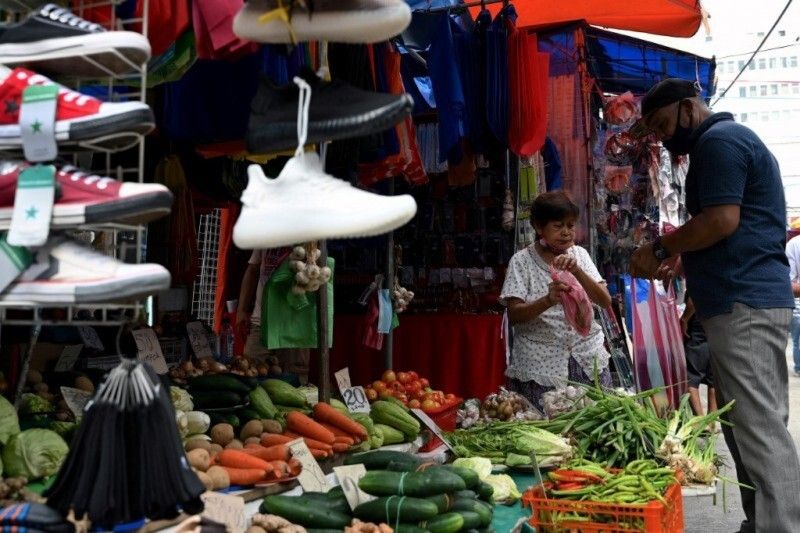Stubbornly high Philippine inflation dilutes benefits of a weak peso

MANILA, Philippines — As the Philippine peso hovers within 17-year lows, money sent home by Filipinos abroad are getting a boost.
Ideally, the gains should translate to stronger purchasing power for the families of these expats, but not for Melissa Tresvalles, a 31-year-old overseas Filipino worker in Saudi Arabia.
“Despite the bigger value of my remittances, prices of consumer items are also rising back home,” she said in an interview. “That’s why my family does not feel the benefits of the weak peso.”
The Bangko Sentral ng Pilipinas has traditionally emphasized the benefits of — and even its preference for — a weak peso. Last week, the local unit touched the all-time low of P56.45 against the greenback as an aggressive US Federal Reserve triggers capital outflows from emerging markets and prop up demand for dollars.
The Philippines’ rising import bill amid rallying world oil prices is also adding pressure on the country’s currency.
Apart from boosting remittances and helping stimulate consumption, a depreciating currency can also help exporters gain more market share by making the prices of their products cheaper compared to other goods that are priced at stronger currencies. At the same time, a weak currency can boost the central bank’s earnings as the BSP may opt to sell dollars from its holdings to arrest a deeper currency slump.
But some of those benefits are hardly manifesting these days.
“I have always welcomed a depreciating peso as the benefits reach not only overseas Filipinos and their families but also local manufacturers that compete with cheap imports, exporters, BPOs etc…,” Jun Neri, lead economist at Bank of the Philippine islands, said.
“However, given the extraordinary rise of inflation everywhere in the world, the gains from the depreciation are easily diluted by rising onshore prices of food, transport and even key services,” he added.
Government data shows inflation, as measured by the consumer price index, heated up 6.1% year-on-year in June, the hottest in over three years. State statisticians also reported that the value of P1 back in 2018 is now equivalent to P0.87 in June this year, and other data tells us that stubbornly high prices are already weighing on consumer sentiment.
A quarterly central bank survey released last month found that consumer spending outlook for the third quarter fell to 38.3%, from 40.4% recorded in the first quarter, as households expect prices to go even higher in the coming months. And OFWs, who typically spend over 90% of their remittances on food and other household needs based on BSP data, are not spared from the onslaught of inflation.
When Glyza Biscocho, an airport supervisor for a major airline based in Singapore, flew home last weekend, she was surprised to find consumer prices were zooming.
“My family thinks it’s a good thing because they end up getting more with the same amount when converted to peso. But they don’t see how badly it reflects on the Philippine economy, consumer goods are so expensive,” Biscocho, 28, said in an interview.
Bad to worse
Beyond consumption, inflows from remittances, one of the Philippines’ major sources of dollars, are not seeing a significant increase because a weak peso eases the pressure on OFWs to send home a bigger amount of dollars to cover the peso expenses of their families here. Latest data from the BSP showed cash remittances only grew 1.8% year-on-year in May.
While exports are growing, the Philippines is still grappling with a record trade imbalance as soaring oil prices push up import costs. The BSP’s foreign reserves, meanwhile, are down as the government settles its Covid-19 debts.
As the crashing currency does more harm than good in the economy by fueling inflation, the BSP last week hiked its key rate by a massive 75 basis points (bps) at an off-cycle meeting. The forceful action helped prevent the peso from posting a new record-low, but Nicholas Mapa, senior economist at ING Bank in Manila, said the rate hike’s cooling effect on the economy could make things harder for many Filipinos.
READ: What the BSP's rate hike means for you
“With inflation on the rise, unfortunately Filipinos May face conditions that may slow consumption. On top of this, rate hikes will now make borrowing more expensive, one more reason that should weigh on overall economic conditions,” Mapa said.
Sonny Africa, executive director of non-profit think tank IBON Foundation, agreed with Mapa.
“Inflation will get worse as the peso devaluation and oil prices still keep working their way through the economy in the months to come. Joblessness will worsen as inflation rises, as spending weakens, and as the economy slows,” he said.
- Latest
- Trending





























